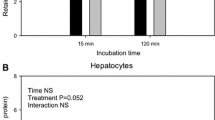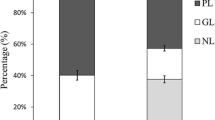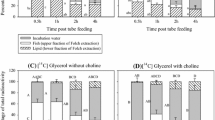Abstract
Despite several studies aimed at evaluating the positional and fatty acid specificity of fish triacylglycerol (TAG) digestive lipases, there is still much uncertainty regarding these issues. The aim of the present study was therefore to address these questions in Atlantic salmon (Salmo salar L.). Crude luminal midgut extracts were collected from fed salmon and the hydrolysis studied for various substrates including triolein (Tri-18:1), trilinolein (Tri-18:2), trilinolenin (Tri-18:3), trieicosapentaenoin (Tri-20:5), tridocosahexaenoin (Tri-22:6) and natural fish oil TAG. Using Tri-18:1, in a time-curve model showed an initial high degree of sn-1 or sn-3 specificity where sn-1,2(2,3)-diacylglycerol (1,2(2,3)-DAG) and free fatty acid (FFA) were the main hydrolytic products up to 15 min. Lack of initial sn-2 specificity was confirmed by negligible sn-1,3-diacylglycerol (1,3-DAG) being produced. During the further hydrolysis of DAG, all positions appeared susceptible to attack causing a concomitantly small increase in sn-1(3)-monoacylglycerol (1(3)-MAG) and 2-MAG, but not at the level expected for an exclusively sn-1,3-specific lipase. Oleic acid (18:1n-9) and eicosapentaenoic acid (20:5n-3) were preferred substrates for hydrolysis using both fish oil and acyl-homogeneous TAGs with FFA as the main product of lipolysis. Hydrolysis of the natural fish oil TAG appeared slower yet produced proportionally more MAG and DAG after 5 min, and similar specificities, as for synthetic TAG substrates, were exhibited with 18:1n-9 and 20:5n-3 accumulating in the FFA fraction after 30 min. Notably, 16:0 was particularly conserved in MAG. As TAG resynthesis of absorbed lipid in salmon enterocytes proceeds preferably with 2-MAG as templates, the absorption of 2-MAG, produced during initial stages of TAG hydrolysis, would need to occur rapidly to be effectively utilised via the MAG pathway.





Similar content being viewed by others
Abbreviations
- DAG:
-
Diacylglycerol
- FFA:
-
Free fatty acid
- FO:
-
Fish oil
- MAG:
-
Monoacylglycerol
- MGAT:
-
Monoacylglycerol acyltransferase
- Tri-18:1:
-
Triolein
- Tri-18:2:
-
Trilinolein
- Tri-18:3:
-
Trilinolenin
- Tri-20:5:
-
Trieicosapentaenoin
- Tri-22:6:
-
Tridocosahexaenoin
- PUFA:
-
Polyunsaturated fatty acid
- TAG:
-
Triacylglycerol
- TLC:
-
Thin-layer chromatography
References
Borgstrom B (1977) Action of bile-salts and other detergents on pancreatic lipase and interaction with colipase. Biochim Biophys Acta 488:381–391
Patton JS, Nevenzel JC, Benson AA (1975) Specificity of digestive lipases in hydrolysis of wax esters and triglycerides studied in anchovy and other selected fish. Lipids 10:575–583
Lombardo D (2001) Bile salt-dependent lipase: its pathophysiological implications. Biochim Biophys Acta 1533:1–28
Mattson FH, Volpenhein RA (1964) The digestion and absorption of triglycerides. J Biol Chem 239:2772–2777
Wang CS, Kuksis A, Manganaro F, Myher JJ, Downs D, Bass HB (1983) Studies on the substrate-specificity of purified human-milk bile salt-activated lipase. J Biol Chem 258:9197–9202
Lehner R, Kuksis A (1996) Biosynthesis of triacylglycerols. Prog Lipid Res 35:169–201
Johnston JM (1977) Gastrointestinal tissue. In: Snyder F (ed), Lipid metabolism in mammals, vol 1. Plenum Press, New York, pp 151–187
Cowey CB, Sargent JR (1977) Lipid nutrition in fish. Comp Biochem Physiol B Biochem Mol Biol 57:269–273
Olsen RE, Ringo E (1997) Lipid digestibility in fish: a review. Recent Res Dev Lipids Res 1:199–265
Tocher DR, Sargent JR (1984) Studies on triacylglycerol, wax ester and sterol ester hydrolases in intestinal ceca of rainbow-trout (Salmo-Gairdneri) fed diets rich in triacylglycerols and wax esters. Comp Biochem Physiol B Biochem Mol Biol 77:561–571
Iijima N, Tanaka S, Ota Y (1998) Purification and characterization of bile salt-activated lipase from the hepatopancreas of red sea bream, Pagrus major. Fish Physlog Biochem 18:59–69
Bogevik AS, Tocher DR, Waagbo R, Olsen RE (2008) Triacylglycerol-, wax ester- and sterol ester-hydrolases in midgut of Atlantic salmon (Salmo salar). Aquacult Nutr 14:93–98
Oxley A, Torstensen BE, Rustan AC, Olsen RE (2005) Enzyme activities of intestinal triacylglycerol and phosphatidylcholine biosynthesis in Atlantic salmon (Salmo salar L.). Comp Biochem Physiol B Biochem Mol Biol 141:77–87
Oxley A, Jutfelt F, Sundell K, Olsen RE (2007) Sn-2-monoacylglycerol, not glycerol, is preferentially utilised for triacylglycerol and phosphatidylcholine biosynthesis in Atlantic salmon (Salmo salar L.) intestine. Comp Biochem Physiol B Biochem Mol Biol 146:115–123
Caballero MJ, Gallardo G, Robaina L, Montero D, Fernandez A, Izquierdo M (2006) Vegetable lipid sources affect in vitro biosynthesis of triacylglycerols and phospholipids in the intestine of sea bream (Sparus aurata). Br J Nutr 95:448–454
Gjellesvik DR, Raae AJ, Walther BT (1989) Partial-purification and characterization of a triglyceride lipase from cod (Gadus-Morhua). Aquaculture 79:177–184
Gjellesvik DR, Lombardo D, Walther BT (1992) Pancreatic bile-salt dependent lipase from Cod (Gadus-Morhua)—purification and properties. Biochim Biophys Acta 1124:123–134
Leger C (1985) Digestion, absorption and transport of lipids. In: Cowey CB, Mackie AM, Bell JG (eds) Nutrition and feeding in fish. Academic Press, London, pp 299–331
Lie O, Lambertsen G (1985) Digestive lipolytic enzymes in cod (Gadus-Morhua)—fatty-acid specificity. Comp Biochem Physiol B Biochem Mol Biol 80:447–450
Lie O, Lied E, Lambertsen G (1987) Lipid digestion in cod (Gadus-Morhua). Comp Biochem Physiol B Biochem Mol Biol 88:697–700
Koven WM, Henderson RJ, Sargent JR (1994) Lipid Digestion in Turbot (Scophthalmus-Maximus). 1. Lipid class and fatty acid composition of digesta from different segments of the digestive-tract. Fish Physiol Biochem 13:69–79
Olsen RE, Myklebust R, Kaino T, Ringo E (1999) Lipid digestibility and ultrastructural changes in the enterocytes of Arctic char (Salvelinus alpinus L.) fed linseed oil and soybean lecithin. Fish Physiol Biochem 21:35–44
Lowry OH, Rosebrough NJ, Farr AL, Randall RJ (1951) Protein measurement with the folin phenol reagent. J Biol Chem 193:265–275
Thomas AE, Scharoun JE, Ralston H (1965) Quantitative estimation of isomeric monoglycerides by thin-layer chromatography. J Am Oil Chem Soc 42:789–792
Christie WW (2003) LIPID ANALYSIS: isolation, separation, identification and structural analysis of lipids. 3rd edn. The Oily Press, Bridgwater
Gjellesvik DR (1991) Fatty acid specificity of bile salt-dependent lipase—enzyme recognition and super-substrate effects. Biochim Biophys Acta 1086:167–172
Rouzer CA, Ghebreselasie K, Marnett LJ (2002) Chemical stability of 2-arachidonylglycerol under biological conditions. Chem Phys Lipids 119:69–82
Sigurgisladottir S, Lall SP, Parrish CC, Ackman RG (1992) Cholestane as a digestibility marker in the absorption of polyunsaturated fatty acid ethyl-esters in Atlantic salmon. Lipids 27:418–424
Halldorsson A, Kristinsson B, Haraldsson GG (2004) Lipase selectivity toward fatty acids commonly found in fish oil. Eur J Lipid Sci Technol 106:79–87
Acknowledgments
This work was supported by the Norwegian Research Council (Grant no. 165051/S40). The authors are also grateful for the skillful assistance of Ivar Helge Matre, Institute of Marine Research, in looking after the fish.
Author information
Authors and Affiliations
Corresponding author
About this article
Cite this article
Bogevik, A.S., Oxley, A. & Olsen, R.E. Hydrolysis of Acyl-Homogeneous and Fish Oil Triacylglycerols Using Desalted Midgut Extract from Atlantic Salmon, Salmo salar . Lipids 43, 655–662 (2008). https://doi.org/10.1007/s11745-008-3185-2
Received:
Accepted:
Published:
Issue Date:
DOI: https://doi.org/10.1007/s11745-008-3185-2




